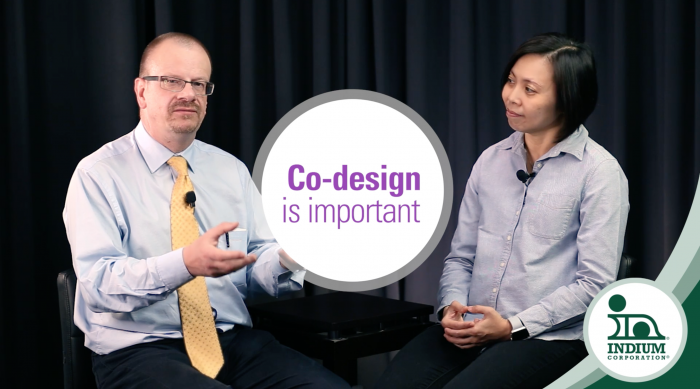Indium Corporation’s Dr. Andy Mackie, Senior Product Manager, Semiconductor and Advanced Assembly Materials, and Sze Pei Lim, Regional Manager, Semiconductor, discuss how different reliability needs drive packaging trends, including Heterogeneous Integration & Assembly (HIA), SiP, and wafer level packaging.
Andy Mackie: You and I, earlier, were talking about heterogeneous integration & assembly.
Sze Pei Lim: Mm-hmm.
Andy Mackie: System-in-package.
Sze Pei Lim: Yep.
Andy Mackie: Wafer-level packaging, panel-level packaging. There's a lot of confusion about the terms within this and we talked about how complicated it is to address that.
Sze Pei Lim: Yup.
Andy Mackie: Is there a way that we can talk about what the different packages are, how they function, and basically what the different terms mean?
Sze Pei Lim: Okay. I think I myself is confused too as of the gray areas right so, to me is the whole big heterogeneous integration. So, it can include the SiP the system-in-package and some of the wafer-level packaging. It can be fan-out SiP, or it can be other kind solder as you have different functions die that has been put together—either in a substrate form or whatever form—and then encapsulate together, become a package that has certain function then we call it a heterogeneous integration or the SiP. And even sometimes you have a SiP with encapsulation and SiP without the encapsulation. So, I think it's very huge space and all this is achieved under heterogeneous integration.
Andy Mackie: Mm-hmm.
Sze Pei Lim: That's what I think, I don't have a very clear kind of segregation, like which is what.
Andy Mackie: Is it useful, perhaps in terms of reliability, to differentiate between system-in-package and these other forms of integration?
Sze Pei Lim: I think it depends on the application, where the final package is going to end up. In automotive, of course, you have a small, stringent kind of reliability requirements but in terms of it being used in the mobile, or just your tablets, or IoT, you may not need that kind of reliability that the automotive industry is asking for.
Andy Mackie: It's becoming important to have co-design of both the thinned, maybe large die—along with the package. The die and the package are no longer separately regarded—they have to be co-designed.
Sze Pei Lim: Yeah, working together, because it's important to have the co-design, so that it can work seamlessly together. Even though they are kind of heterogeneous, they need to work together and form a single package—so that is really important for the co-design thing.
Andy Mackie: The system-in-package is considered a single unit with commerce. For example, you're a cell phone manufacturer, or you mentioned an automotive manufacturer, and you're trying to bring in a functionality in a particular pad set out. Rather than bringing all the components together and putting them down the circuit board, you simply have a simple electrical pad layout, and then you just say to the suppliers hey, we need you to provide a package that looks like this and it's this size, this thickness, that does this. So, you're actually, rather than specifying separate components to do that, you're actually specifying the functionality, and I think that's an increasingly important aspect of certainly cell phone manufacture and integration.
Sze Pei Lim: Yeah, I think certainly the cell phone industry is driving this area. They need to pack as many components into the cell phone as much as possible to have increased functionalities and saving power at the same time and have a reasonable amount of reliability all this, yeah, I think that is why you have all this falling into place.
Andy Mackie: Thank you.
Sze Pei Lim: Welcome.
Andy Mackie: If you have any more questions, feel free to contact us. And, Sze Pei, it's been a pleasure as always.
Sze Pei Lim: Thank you.


